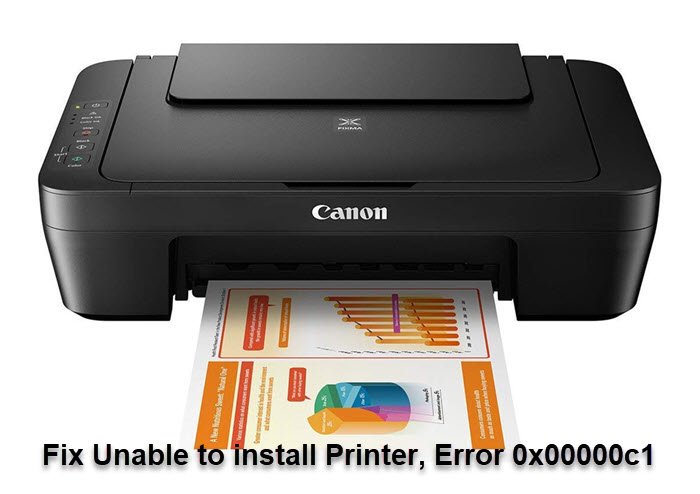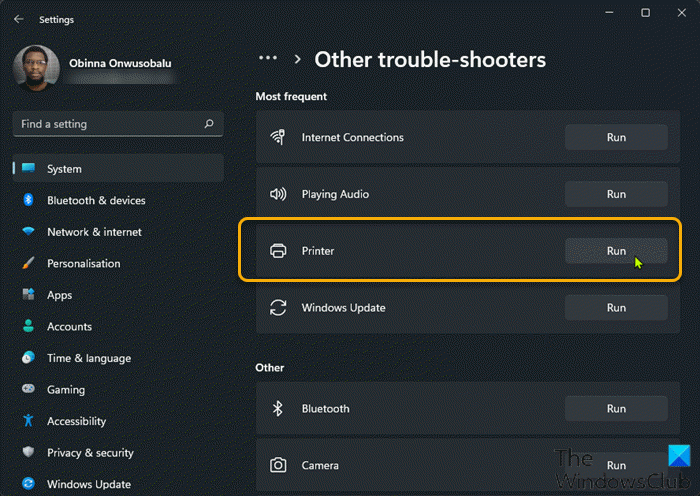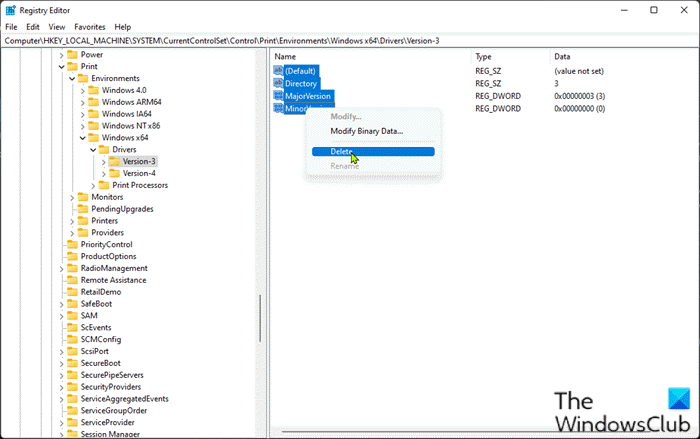If you encounter the error message Unable to install Printer, with Error code 0x00000c1 when trying to add a printer to your Windows 11 or Windows 10 computer, then this post is intended to help you. In this post, we will provide the most adequate solutions you can try to resolve this issue.

What is error 0x000000c1?
PC users that encounter the Error code “0x000000c1”, should know the error is one of the issues that users may get as a result of incorrect or failed installation or uninstallation of software that may have left invalid entries in system elements. Basically, If you have received this warning on your PC, it means that there was a malfunction in your system operation.
Error 0x00000c1, Unable to install Printer
If you’re unable to install Printer on your Windows 11/10 PC, you can try our recommended solutions below in no particular order and see if that helps to resolve the Error 0x00000c1.
- Check the printer connection
- Run Printer Troubleshooter
- Update Printer drivers
- Restart the Print Spooler service
- Modify the Registry
- Disconnect and reconnect the Printer
Let’s take a look at the description of the process involved concerning each of the listed solutions.
1] Check the printer connection
The first thing you can try to resolve the Unable to install Printer, Error 0x00000c1 is to check the printer connection. Here, you need to check if all power cables of the printer are properly working. If you are using a shared printer on a network, make sure all electrical ports, Power switches, Router, and any other connected hardware is turned on and functioning as it should. If you have a wireless printer, make sure to check the Printer’s wireless option (Blue Icon). This should always remain turned on.
Try the next solution if the printer connection all checks out, but the issue persists.
2] Run Printer Troubleshooter

Running the Windows 11/10 in-built Troubleshooter will restart your printer and drivers and check for any errors. Your printer must be connected during this procedure.
To run the Printer Troubleshooter, do the following:
- Press Windows key + I to open Settings.
- Click System on the left navigation pane.
- Click Troubleshoot on the right pane.
- Next, click Other trouble-shooters.
- Click Run button for Printer.
3] Update Printer drivers
This solution requires you to make sure you have installed the latest print drivers for your printer. You can download the latest version of the printer driver from the manufacturer’s website.
Alternatively, you can update the printer driver via Device Manager. Here’s how:
- Press Windows key + X to open the Power User Menu.
- Press M key on the keyboard to open Device Manager.
- Once you’re inside Device Manager, scroll down through the list of installed devices and expand the Print queues section.
- Next, right-click on the printer that you’re having issues with and choose Update driver from the context menu.
- At the next screen, click on Search automatically for updated driver software.
- Wait until the scan is complete. If a new driver version is found, follow the on-screen instructions to download & install it on your computer.
- Restart your device.
On boot, see if the issue is resolved or not. Try the next solution if the error reappears.
4] Restart the Print Spooler service
To restart the Print Spooler service on your Windows system, do the following:
- Press Windows key + R to invoke the Run dialog.
- In the Run dialog box type services.msc and hit Enter to open Services window.
- In the Services window, locate the Print Spooler service.
- Right-click on Print Spooler and select Properties.
- In the Properties window, click Stop.
This will stop the print queue process. Keep the Print Spooler Properties window open.
- Now, press Windows key + E to open File Explorer.
- Navigate to the following location:
C:\WINDOWS\system32\spool\PRINTERS
- Delete all the files in the Printers folder.
If you don’t see any files, you may need to show hidden files/folders.
- Close the File Explorer window.
- In the Print Spooler Properties window, click the Start button to restart the service.
Restart your computer once again and reinstall the necessary printer drivers at the next computer startup. See if the issue is resolved. Otherwise, try the next solution.
5] Modify the Registry

Since this is a registry operation, it is recommended that you back up the registry or create a system restore point as necessary precautionary measures. Once done, you can proceed as follows:
- Press Windows key + R to invoke the Run dialog.
- In the Run dialog box, type regedit and hit Enter to open Registry Editor.
- Navigate or jump to the registry key path below:
HKEY_LOCAL_MACHINE\SYSTEM\CurrentControlSet\Control\Print\Environments\Windows x64\Drivers\
- At the location, click the Version-3 folder under Drivers at the left navigation pane.
- On the right pane, delete all the registry entry.
- Repeat if there’s any other Version-X folder.
- Exit Registry Editor when done.
- Restart PC.
On boot, check if the issue is is resolved. If not, try the next solution.
6] Disconnect and reconnect the Printer
If nothing has worked so far for you, you can simply disconnect the Printer by unplugging its cable. Restart your PC, reconnect the cable to the respective USB port, and turn on the printer, then Install or Add the Local Printer to your Windows 11/10 PC.
How do you fix Windows cannot connect to the printer?
To fix Windows cannot connect to the printer error you can follow these instructions: Press Windows key + R and then type printmanagement.msc in the Run box and click OK button. In the left pane, click All Drivers. In the right pane, right-click on the printer driver and click Delete on the pop-up menu. Add the printer again.
Related post: Windows cannot connect to the printer, 0x0000052e, Operation failed.
Leave a Reply